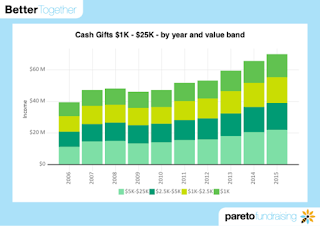(OR The Math of Mid Level Donors for my American friends)
Firstly, well done for reading past the
title. The word Math can scare many
fundraisers away.
But I know that any serious fundraiser
knows they need to understand more about the actual numbers behind fundraising.
That’s why I am writing a series of blogs and running a webinar with Roger Craver on this topic.
In the years I have been working in
fundraising, I have noticed that many Major Donor programs fail. Most charities struggle to make them
work.
You have probably noticed that most mega
donations go to universities, hospitals, schools, zoos etc. Rarely do ‘classic’
charities like Make A Wish, Cancer Research, WWF and Save the Children get
these mega gifts. Usually only if they
are running a capital campaign.
Yet generally when we start a revenue major
donor program, we think big! Maybe not $5m from Dick Smith, Richard Branson or
Bill Gates BIG, but certainly aiming for over $100,000. And mostly our aim misses. Badly.
Of 75* Australian charities, including most
of the top thirty fundraising charities, we see little income from $100,000
plus donations. Even drilling down to $25,000 plus we don’t find a growing pot
of gold.
Note the chart below showing these
charities raised about $30m from donors giving more than$25,000 in 2007. And it was about the same in 2015.
In the same time frame, total revenue from
individuals went grew from $800m to $1.4bn: Clearly we are under performing in
the higher value areas.
When a charity has a major donor strategy, most
are aimed at donations above $25,000. But there’s a lot of benefit in working
with donors who give less than that.
Some charities have done so much better by
setting up systems and processes to grow the donations of people around $1,000
to $25,000 through a combination of better direct mail, stewardship and visiting.
The growth in this area is much better.
The chart below shows growth from about
$45m to nearly $75m:
I don’t think we should ignore the
potential from the group of donors giving at levels above $25,000 but we
certainly should think about the group a little below that first.
Why?
There are more of them. It is easier to
reach. You can get results very, very quickly.
In my next article, I will look at where
these people come from.
Sean
* A load of Kiwi and Aussie charities come
together and share analysis of donations every year in the Pareto Benchmarking
study.


1 comment:
Looking forward to discussing in more depth Sean...
Post a Comment